Barnard Castle: Stronghold of the North
by Dr. Gareth Evans
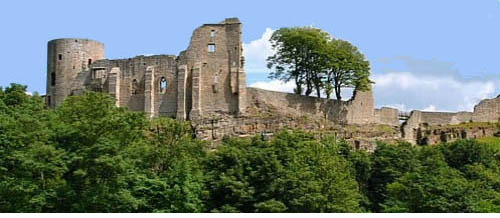
Lying beside the River Tees, to the south west of the City of Durham, the town of Barnard Castle ranks amongst Britain's top fifty most historically and architecturally important towns.
Built in the protective shadow of the superbly sited 12th Century fortification that gives the town its name, "Barney" (as it is locally known) enjoys a colourful and unique history reaching back to the days of the Roman occupation and beyond.
Today a thriving market town and administrative centre, in addition to its eponymous medieval ruin, Barnard Castle has some of the best antique shops in the North of England and hosts the Bowes Museum, with its unrivalled collection of 15th-19th Century European art.
Roman Times
The Roman occupation of this region lasted over three centuries, from approximately A.D. 79 -- 410 and was a time of contrasts marked by both turbulence and prosperity. The need to keep a firm grasp on this part of the Empire's northern outpost is clearly shown by the string of military sites along the Roman roads in the area -- forts such as Binchester, Piercebridge, Catterick, Greta Bridge, Bowes and Brough. However, over time the acceptance of Roman ways and the gradual integration of native population and occupiers also brought significant economic benefits to the area. The forts, once symbols of repression, became important population centres as settlements developed around them, such as the large town at Catterick and a collection of Villas at Piercebridge.
The 12-feet wide roadway accidentally discovered during excavations to extend Barney's now long demolished gasworks is thought to be part of a Roman road from Bowes (Lavatrae) to Binchester (Vinovium), which links with the other road from Piercebridge (Maglova). This, together with its commanding strategic position overlooking the Roman ford that crossed the River Tees, would seem to suggest that Barnard Castle was a place of some importance during the period.
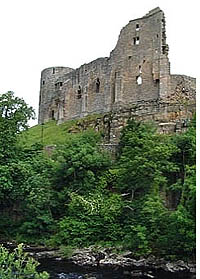
The Castle
The Castle itself dates back to Norman times, being built by Bernard Balliol between 1112 - 1132. His father, Guy de Baliol, had come to England with William the Conqueror's invading army and was given the land by William Rufus, around 1093. This fortress -- "Bernard's Castle" -- like the Roman forts before it, became a focus for settlement and the town of Barnard Castle developed around it.
The Castle remained an important stronghold throughout the intervening centuries, until 1569 and the "Rising of the North" -- plotted at the nearby Raby Castle -- saw it besieged by the supporters of Mary Queen of Scots. For eleven days, Sir George Bowes of Streatlam held the fort for his sovereign, Elizabeth I, before being forced to surrender it "for want of provisions, upon honorable terms, being allowed to depart with arms, ammunition and baggage." In many ways this was the Castle's most significant contribution to history, for the rebels' victory was ultimately to prove a costly one. The delay Sir George had gallantly forced upon them broke something of their impetus and bought the Crown much-needed time; ultimately the "Great Rebellion" foundered and failed.
The Bowes Museum
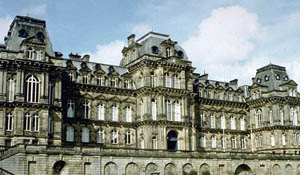 The world famous Museum was built in the style of a French chateau and opened in 1892 to house the art collection of Josephine and John Bowes. It comprises a remarkable selection of European fine and decorative arts spanning the period from 1400 to 1875 that is unrivalled in northern England and one of the most outstanding in Britain. Given the architectural emphasis of the building, the collection's particular focus on French art is perhaps no surprise, some of the items having been brought to the Museum from the Bowes' home in Paris. Paintings by Spanish artists are also well represented and there are significant examples of works by Italian and Northern European painters. The collection also features furniture, ceramics and textiles, together with extensive displays of archaeological material -- some from the nearby Kirk Carrion burial site -- and the social history of the area.
The world famous Museum was built in the style of a French chateau and opened in 1892 to house the art collection of Josephine and John Bowes. It comprises a remarkable selection of European fine and decorative arts spanning the period from 1400 to 1875 that is unrivalled in northern England and one of the most outstanding in Britain. Given the architectural emphasis of the building, the collection's particular focus on French art is perhaps no surprise, some of the items having been brought to the Museum from the Bowes' home in Paris. Paintings by Spanish artists are also well represented and there are significant examples of works by Italian and Northern European painters. The collection also features furniture, ceramics and textiles, together with extensive displays of archaeological material -- some from the nearby Kirk Carrion burial site -- and the social history of the area.
Probably the best known and most instantly recognised artefact in the Bowes Museum is the Silver Swan, a clockwork, musical automaton which, despite its age, can still be seen operating at selected times. First mentioned in the possession of the 18th Century London jeweller and showman James Cox, the swan actually merited a description in the 1773 act of Parliament permitting Cox to disperse his collection by lottery. Its fate thereafter is not entirely certain. It was described in Weeks's Museum and at some point may have travelled to Scotland -- the name of Lunan, an Aberdonian watchmaker is inscribed on it -- before being sold at Christies in 1864. Harry Emanuel, the London jeweller exhibited it at the 1867 Paris International Exhibition, where it was apparently seen by Mark Twain, who was to describe it later in The Innocents Abroad. In 1872 it entered the Bowes collection, sold to John Bowes by the Parisian jeweller Briquet.
Town History
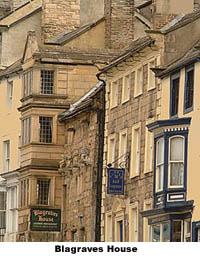 A walk through the town of Barnard Castle is guaranteed to reveal many snippets of historical interest. The town has four main access ways or "gates" -- Galgate, Newgate, Thorngate and Bridgegate. Galgate, the principal route, largely follows the old road built by the Romans and at its end lies the Scar Top hill and the ruins of Bernard Balliol's fortress. It then follows the curve of the old castle wall into Horse Market, the main street.
A walk through the town of Barnard Castle is guaranteed to reveal many snippets of historical interest. The town has four main access ways or "gates" -- Galgate, Newgate, Thorngate and Bridgegate. Galgate, the principal route, largely follows the old road built by the Romans and at its end lies the Scar Top hill and the ruins of Bernard Balliol's fortress. It then follows the curve of the old castle wall into Horse Market, the main street.
In early 1838, Charles Dickens, accompanied by Hablot K. Brown ("Phiz"), stayed here (at the King's Head) while researching his book Nicholas Nickleby, which was published shortly afterwards and in which the town gets a passing mention. The aptly named Market Place is an old cobbled section where an open market is still held on every Wednesday, and at its head stands the Market Cross. This octagonal building was built by Thomas Breaks in 1747, its alternative name -- "Butter Mart" -- coming from the practice of selling dairy produce on the ground floor.
It has been put to a number of uses in its time, including being a fire station and a court house, but certainly none stranger than settling a bet between two erstwhile snipers. In 1803, amid fears of an imminent Napoleonic invasion, an argument broke out between a local man called Taylor -- one of the Teesdale Legion of Volunteers garrisoned in the town -- and Cruddas, the Earl of Strathmore's gamekeeper, as to who was the better marksman. To put it to the test, standing outside the Turk's Head Inn, they each fired one shot at their selected target -- the weather vane on the Market Cross. Both bullet holes remain to this day, a testament to how well they were matched.
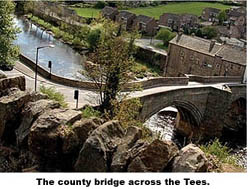 To the left lies Newgate and the Bowes Museum; ahead, down the bank lies Blagraves House -- one of the oldest buildings in the town and now an excellent restaurant. Beyond lies Bridgegate and the County Bridge. Built in 1569 -- the inscription on its stone-work of "1596" is allegedly the result of a 20th Century stonemason's error -- the bridge's name arose from the fact that up until 1974 the Tees formed the boundary between County Durham and North Yorkshire. It also marked the boundaries of two Bishoprics and local legend has it that illicit weddings were conducted in the middle of the bridge to avoid objection by either cleric. Whether or not this story is true, Barnard Castle certainly has witnessed some strange things in its 2000 year history.
To the left lies Newgate and the Bowes Museum; ahead, down the bank lies Blagraves House -- one of the oldest buildings in the town and now an excellent restaurant. Beyond lies Bridgegate and the County Bridge. Built in 1569 -- the inscription on its stone-work of "1596" is allegedly the result of a 20th Century stonemason's error -- the bridge's name arose from the fact that up until 1974 the Tees formed the boundary between County Durham and North Yorkshire. It also marked the boundaries of two Bishoprics and local legend has it that illicit weddings were conducted in the middle of the bridge to avoid objection by either cleric. Whether or not this story is true, Barnard Castle certainly has witnessed some strange things in its 2000 year history.
Location
The Town of Barnard Castle is in County Durham, in the North East of England, about 25 miles south west of the City of Durham, 16 miles west of Darlington and around 50 miles away from the heart of the Lake District. It is easily accessible from all directions (A688 from the north, A1 from the south and along the A66 from east or west).
Worth a Stop Nearby: Kirk Carrion
Dominating the Lunedale ridge, the pine-covered tumulus of Kirk Carrion is one of the region's major Bronze Age burial sites. Thought to have been constructed sometime around 1400 BC, this elaborate chieftain's tomb was excavated in Victorian times.
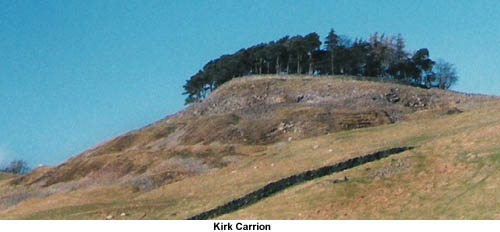
As befits a site of such antiquity, there are several local legends about the spot. It is said that within its circle of trees there is a place where no wind ever blows, no matter how rough the weather, but since the location of this point itself is supposed to be constantly shifting, it is a difficult thing to verify. The site is also reputed to be haunted. The identity of the ghost varies -- the original Bronze Age inhabitant, one of the Victorian diggers or the land-owner who gave permission for the excavation -- but the vengeful nature of the spectre remains a fairly constant feature in all versions. Whatever the truth of the story, at times the mound -- which is said to lie on a ley line -- can be an unusual and oddly atmospheric sight, even in full sunshine.
Today the site, which can be seen from most of the surrounding countryside, is probably best known for the annual fell run which bears its name. Held during the Middleton in Teesdale Gala, the two-and-a-half mile race starts in the town's market place, before crossing the Tees and following the Pennine Way, climbing 550 feet towards the summit and then returning.
Kirk Carrion is approximately one mile south west of Middleton in Teesdale. The B6276 (Middleton to Brough) road through Lunedale provides the nearest approach by vehicle; public footpaths provide access for walkers.
Related Articles:
- The Bowes Museum, by Alasdair Carter
- https://www.timetravel-britain.com/articles/museums/bowes.shtml
More Information:
We regret that we no longer have the resources to maintain up-to-date links and/or hours and pricing details for the various sites and attractions listed on this website. For more information about the location(s) listed above, please use your favorite search engine or visit Wikipedia.
Gareth Evans is a freelance writer and photographer, having previously worked in the private sector before lecturing at the University of Durham. Having travelled extensively, he now concentrates on writing about subjects much closer to home -- both geographically and metaphorically. He is particularly interested in myths, legends and folklore, together with the often forgotten history of the Celtic lands, especially that of his own native Wales and Scotland, his adopted home. Gareth is currently planning his next book, looking at the role of the pagan Horned God in myth and history.
Article and photos © 2005 Gareth Evans
|
